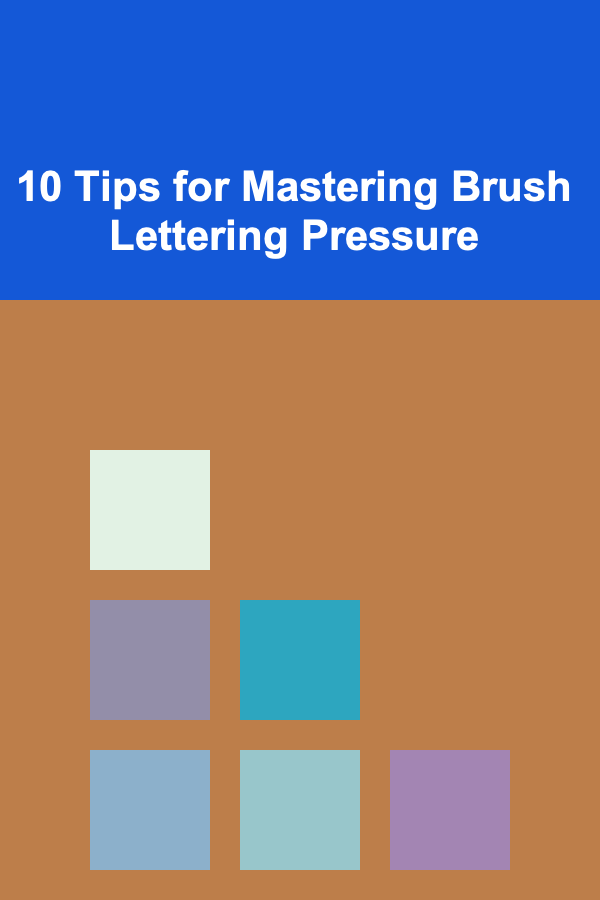
10 Tips for Mastering Brush Lettering Pressure
ebook include PDF & Audio bundle (Micro Guide)
$12.99$6.99
Limited Time Offer! Order within the next:

Brush lettering is an art form that requires not only creativity but also a solid understanding of how to control pressure to create beautiful and dynamic strokes. The ability to master brush lettering pressure is essential for achieving that distinct, professional look with a brush pen, making the strokes thick and thin in all the right places. Whether you are a beginner or an experienced hand, improving your control over pressure can elevate your lettering skills to new heights.
This article provides 10 essential tips to help you master the technique of pressure control in brush lettering. Each tip focuses on different aspects of brush pressure, from understanding the basics to applying advanced techniques that will refine your art.
Understand the Basics of Brush Pen Pressure
Before diving into the complexities of brush lettering pressure, it's crucial to understand what pressure control actually entails. The basic principle of brush lettering involves varying the pressure you apply on the brush to create strokes that transition from thin to thick. When you push harder on the brush pen, the bristles spread out, resulting in thicker lines. Conversely, when you apply lighter pressure, the bristles stay together, creating thin lines.
Key Points:
- Upstrokes: These should be light, requiring minimal pressure. This helps create fine, delicate lines.
- Downstrokes: These should be heavier, requiring more pressure. This results in thicker lines that provide the contrast needed in brush lettering.
Mastering the contrast between upstrokes and downstrokes is the foundation of beautiful brush lettering. This is where the dynamic effect of brush lettering is achieved.
Use Proper Posture and Grip
The way you hold your brush pen and your body posture play a significant role in your ability to control pressure effectively. A relaxed grip and comfortable posture help you maintain a steady hand, preventing excessive tension that can result in inconsistent strokes.
Tips for Grip:
- Grip the pen lightly: Avoid holding the brush pen too tightly, as this can result in stiff and unnatural strokes. A light, relaxed grip allows for better fluidity and control.
- Position your hand: Keep your hand relaxed and move it from your wrist or forearm, rather than your fingers alone. This will allow you to make larger, smoother strokes.
Posture:
- Sit upright: Ensure that your posture supports a relaxed hand. Avoid slouching, which can lead to shaky movements.
- Proper paper positioning: Position your paper at an angle that feels comfortable, typically at around 45 degrees, to maintain smooth movement.
When you align your posture and grip, you'll have better control over the pressure you apply, allowing for smoother transitions between thin and thick strokes.
Start with Simple Strokes
Before you begin forming letters or words, it's important to practice basic strokes. These will help you get a feel for how much pressure to apply during different parts of a stroke.
Recommended Strokes to Practice:
- Thin upstrokes: Focus on applying as little pressure as possible for the finest line.
- Thick downstrokes: Gradually apply more pressure to achieve thicker, bold lines.
- Transitions: Practice the transition from thin to thick, ensuring the change in pressure is smooth and controlled.
By mastering individual strokes, you gain better control over the pressure needed to create perfect lettering.
Slow Down to Improve Pressure Control
One of the biggest challenges when learning brush lettering is developing the muscle memory to apply the right amount of pressure at the right time. To build this muscle memory, it's important to slow down your strokes initially. Moving too quickly can cause inconsistent pressure, leading to jagged or uneven strokes.
Benefits of Slowing Down:
- Better control: When you slow down, you have more time to think about the pressure you're applying and can adjust it accordingly.
- Consistency: It's easier to create smooth transitions between thin and thick strokes when you give yourself the time to control each one.
As you get more comfortable, you can speed up your strokes, but always be mindful of maintaining consistent pressure throughout.
Use the Right Brush Pen
The brush pen you choose plays a significant role in your ability to control pressure. Not all pens are made equal when it comes to pressure sensitivity, so selecting the right one is critical for beginners and advanced letterers alike.
Key Features to Look For:
- Flexibility: Look for a brush pen with a flexible tip that responds well to changes in pressure.
- Consistency: The pen should produce consistent ink flow as you apply different amounts of pressure. A pen with uneven flow may make it harder to control the thickness of your strokes.
- Tip size: The size of the brush tip affects the range of pressure you can apply. Smaller tips may require more precision, while larger tips provide more flexibility.
Experimenting with different pens will help you find one that suits your style and allows you to master pressure control effectively.
Practice Pressure Gradients
One of the most visually appealing aspects of brush lettering is the gradient effect that comes from varying pressure. A skilled brush letterer can smoothly transition from thin to thick, creating a soft gradient between the upstroke and downstroke.
How to Practice:
- Gradual pressure shifts: Instead of immediately switching from light to heavy pressure, try to gradually increase and decrease the pressure as you move along a stroke.
- Create smooth transitions: The key is to make sure that the change from light to heavy pressure---and vice versa---is seamless.
By mastering pressure gradients, you'll enhance the fluidity and sophistication of your brush lettering.
Experiment with Different Angles
The angle at which you hold your brush pen can impact the way pressure is applied. By experimenting with different angles, you can control the pressure in different ways, influencing the line quality.
Tips for Angles:
- Hold the pen upright: Holding the pen at a 90-degree angle to the paper generally creates a more uniform pressure, which is ideal for beginner-level strokes.
- Tilt the pen: Holding the pen at a slight angle (around 45 degrees) allows the brush tip to spread more easily, creating thicker downstrokes.
Experimenting with these angles will help you find the pressure technique that best suits your lettering style.
Use Different Types of Paper
The type of paper you use can have a significant impact on the way pressure is applied. Softer papers tend to absorb more ink, while smoother papers can result in cleaner strokes. Understanding the characteristics of different types of paper can help you adjust your pressure control.
Types of Paper to Try:
- Textured paper: This type of paper can provide a bit of resistance, helping you feel the pressure more as you write.
- Smooth paper: Smooth paper provides a slick surface, allowing for easier glide and requiring more attention to pressure control.
- Watercolor paper: If you're using ink or watercolor brush pens, watercolor paper provides a great surface, though it may absorb more ink and require lighter pressure.
Experimenting with different papers can help you discover which surface allows you to control pressure most effectively.
Learn to Let Go of Perfection
Brush lettering, like any form of art, requires a balance of precision and freedom. While mastering pressure control is important, it's equally important to let go of the need for perfection. Striving for perfect lines may cause you to tense up, which can restrict your ability to apply pressure smoothly.
Embrace Imperfection:
- Allow your lines to flow: Focus on the movement rather than striving for perfection with each stroke.
- Accept organic variations: Brush lettering has natural imperfections, and these variations contribute to its charm.
By embracing the beauty of imperfection, you'll develop a more fluid and confident approach to pressure control.
Keep Practicing and Be Patient
Mastering brush lettering pressure takes time and patience. As with any skill, consistent practice is the key to improvement. The more you practice, the better your muscle memory will become, allowing you to apply the right amount of pressure naturally.
Practice Suggestions:
- Daily practice: Dedicate a few minutes each day to practicing strokes, letters, and words.
- Track progress: Keep a journal of your practice sessions to note what works and what doesn't.
- Challenge yourself: Set small goals, such as mastering a certain letterform or phrase, to track your improvement.
Patience and perseverance are essential to becoming proficient at brush lettering pressure control. Remember, the more you practice, the more effortless it will become.
Conclusion
Mastering brush lettering pressure is a journey that requires patience, practice, and persistence. By understanding the principles of pressure control, experimenting with different techniques, and practicing regularly, you'll gradually develop the skill to create dynamic and beautiful lettering. Remember that perfection is not the goal; instead, focus on creating smooth transitions between thin and thick strokes, embracing the natural variations that come with the art. Keep practicing, and in time, you'll master brush lettering pressure and elevate your lettering skills to an impressive level.
Reading More From Our Other Websites
- [Home Security 101] How to Prevent Garage Door Theft and Break-ins
- [Home Pet Care 101] How to Choose the Right Dog Boarding at The Ranch
- [Personal Care Tips 101] How to Choose Hand Cream for Post-Manicure Care
- [Mindful Eating Tip 101] The Science Behind Mindful Eating: Why It's a Game‑Changer for Diabetic Health
- [Organization Tip 101] How to Create a Sustainable Seasonal Wardrobe
- [Home Rental Property 101] How to Keep Your Rental Property Safe and Secure for Tenants
- [Sewing Tip 101] Sewing Adventures: 10 Easy Projects Every Kid Can Master
- [Stamp Making Tip 101] Top Must-Have Tools for Beginner Stamp Makers
- [Home Rental Property 101] How to Keep Up with Market Trends in Rental Properties
- [Personal Care Tips 101] How to Refresh Your Skin with Body Spray During the Summer Heat

How to Make Money Online as a Survey Taker: 10 Actionable Ideas
Read More
The Ultimate Guide to Budget-Friendly Vacation Planning: Travel on a Shoestring
Read More
How to Make Homemade Nut Milks
Read More
How to Eat Healthy for Brain Health
Read More
How to Customize Printable Board Games for Different Age Groups
Read More
10 Tips for Optimizing Your Road Bike Fit
Read MoreOther Products

How to Make Money Online as a Survey Taker: 10 Actionable Ideas
Read More
The Ultimate Guide to Budget-Friendly Vacation Planning: Travel on a Shoestring
Read More
How to Make Homemade Nut Milks
Read More
How to Eat Healthy for Brain Health
Read More
How to Customize Printable Board Games for Different Age Groups
Read More